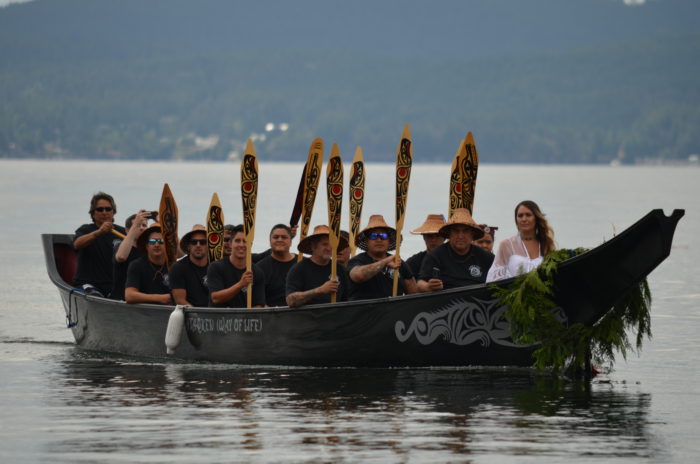Traditional wedding joins Tla’amin couple in culture
By Cyndi Pallen (čɩnɛ), Tla’amin Nation
A beautiful Coast Salish wedding ceremony that took place on the shore of Tla’amin Nation’s territory will be remembered for generations to come.
The sacred union of Mario Brandon Paul (Chegah gewmotl) and Tana Harry (Kiyah) took place at Willingdon Beach on Aug. 11. The ceremony reflected the culture and traditional teachings of Tla’amin and the ancestors and forefathers of the Tla’amin, Klahoose and Homalco.
Both the bride and groom were brought up in Tla’amin and their families reside here. It was Mario’s dream to have a traditional wedding ceremony, and this became a reality with the support of family and friends. The day will be remembered by a vision of the beautiful bride dressed a white Coast Salish shawl with deer buckskin skirt. Kiyah was paddled ashore on a traditional canoe called Ohtaqken, which means “a way of life” in Tla’amin. It was a very proud moment for Kiyah’s father Leonard Harry, who escorted his daughter from the canoe to the ceremonial location on the beach overseeing the Salish Sea.
The canoe was skippered by Mario’s father Sherman Pallen, with eight groomsmen including Mario’s son Jayden. The groomsmen wore t-shirts that featured prints of traditional designs and paddles that were designed by Sherman Pallen. These proudly painted paddles took months to create, and took careful consideration. The paddles complemented the traditional component of this wedding and were gifted to the groomsman.
Lillooet Elder Gerry Oleman conducted the wedding ceremony for the young couple, which was a remarkable experience for guests and onlookers to witness. The ceremony began by having both families called on and to acknowledge the families are now together. The couple was placed on four layers of blankets to represent the teachings of the Medicine Wheel: the four directions, as well as emotional, physical, mental, spiritual wellbeing and the four races of the world. Gerry had directed Sherman to prepare two cedar woven headbands, which both the bride and groom wore to represent their thoughts moving forward as a union. The headbands were to remind them to regulate the words spoken and their thoughts and they move towards the future. A braided rope with leather strands was wrapped around the bride and groom to represent two becoming one.
After the ceremony was over, the couple was wrapped in one blanket, and were told that they are loved and cared for by all the family and friends who were there to share in this important day. The official guest list was 125, however many people passing by the park were able to witness. The traditional ceremony was followed by a formal wedding with a tuxedo and a white dress, and an evening of celebration with family and friends.
Acknowledgements to my husband Sherman Pallen, who spent months preparing the carved paddles, the designs on t-shirts worn by the groomsmen and the bride’s shawl. Sherman was significant in giving the name “Ohtaqken” to the traditional canoe, which was used to mark this day in the traditions of our forefathers. It was a proud moment in time in our community, as it has been more than 100 years since this type of ceremony has taken place. This day represented one aspect of decolonization and a historic moment. We are sure that our families who have gone before us would have been so proud to see this day and the practice of language, art, culture and traditions through songs and dance. It will be remembered by many for years to come.
All my relations, Emote, Qui’he’gunne’.





